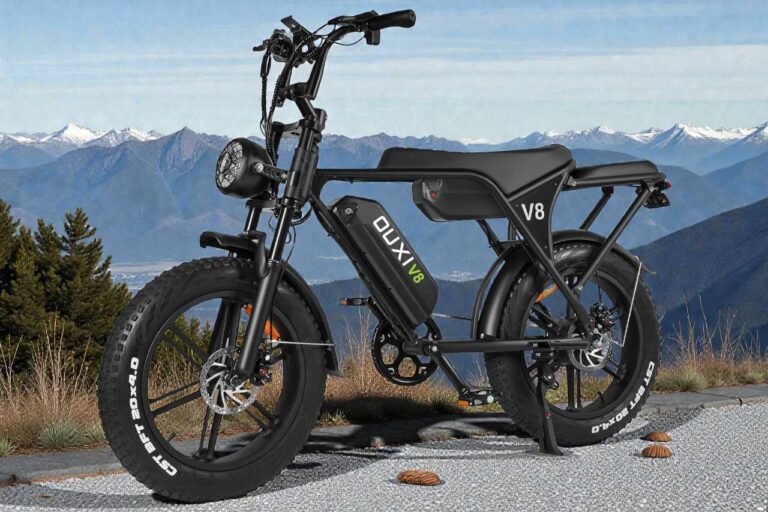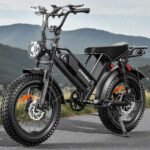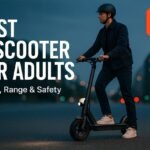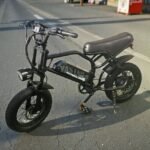

Fcgeoi EB3 Ultra Electric Bike — Budget-Friendly Class-2 Commuter
Our take: 750W peak assist, 36V 10.4Ah removable battery and 26″ tires deliver comfortable, low-maintenance city miles up to 60 per charge.
- 750W peak hub + 7-speed: smooth, confident 20 mph city pacing
- 36V 10.4Ah removable battery: 3–4h charge, up to 60 miles per ride
- Front fork, 26″ tires, dual disc brakes & bright lights; UL 2849 / IPX4
- Motor
- 750W Peak
- Battery
- 36V 10.4Ah
- Top Speed
- 20 mph (Class 2)
- Range
- Up to 60 mi
If you’ve been hunting for a no-drama commuter e-bike that doesn’t wreck your budget, the Fcgeoi EB3 Ultra will be on your shortlist. On paper it’s the classic urban recipe: a 750W peak rear hub motor, a removable 36V battery, front suspension, 26-inch tires, dual disc brakes, and a clean step-over frame that can handle city streets and light paths. In practice, it’s a simple, confidence-building ride that gets the fundamentals right and avoids gimmicks.
The EB3 Ultra is offered in a few configurations (26" or 20" wheels, 7- or 5-speed drivetrains), but this review focuses on the mainstream 26-inch/7-speed version—the one most commuters will gravitate toward. Top speed is rated at 20 mph, and range can stretch up to 60 miles with thoughtful pedal assist. The battery clicks out in seconds for indoor charging, and the bike arrives with useful touches like full lighting, plastic fenders, and an LCD display that even adds cruise control for longer straightaways.
Fcgeoi isn’t chasing boutique credentials. The brand is squarely in the value camp, and the EB3 Ultra is the kind of bike designed to be assembled in an evening, ridden the next morning, and maintained with basic tools. What matters here isn’t flash—it’s the ratio of performance to price and the feeling that you can depend on it day in, day out.
Is the Fcgeoi EB3 Ultra for you?
The EB3 Ultra solves a very specific problem: how to cover daily miles around town without relying on a car, transit schedule, or expensive e-bike. If your commute weaves through neighborhood streets, bike lanes, or mixed-surface greenways, the 26" tires and front suspension fork smooth out cracked pavement and occasional gravel. You’ll cruise comfortably at 15–20 mph with five assist levels (speed-capped at 10/12/15/18/20 mph), and the 7-speed drivetrain gives you a familiar cadence on flats and moderate hills.
It’s a great fit for riders 5'2"–6'4" thanks to generous seatpost adjustment, and the 330 lb payload ceiling accommodates a wide range of riders with a backpack or light panniers. If you want to keep the battery at home or charge at your desk, the removable pack makes that painless. For anyone trying e-bikes for the first time, the EB3 Ultra is beginner-friendly—the controls are simple, the LCD is readable at a glance, and mechanical disc brakes are easy to tune.
Who should pass? Performance seekers wanting a 28 mph Class 3 ride, hydraulic brakes, mid-drive torque, or a factory cargo rack will find this model limiting. If your rides are truly off-road, the urban-leaning geometry and fork are better suited to paths than rock gardens. In terms of budget, the EB3 Ultra is solidly “budget”; that’s its superpower. You’re trading premium components for a very approachable price point—and you’ll feel that in a few places I’ll outline below.
What We Like About the EB3 Ultra
What stands out first is how approachable the bike feels. The frame geometry puts you in a neutral, slightly athletic position, the kind that lets you see over traffic without putting pressure on your wrists. The 750W peak hub motor (60 Nm) delivers a friendly, predictable push off the line. It’s not the kind of snap that rips the front wheel loose, but it absolutely makes headwinds and small climbs feel manageable—exactly what a commuter needs.
The battery system is well-judged. At 36V/10.4Ah, it’s not trying to set range records, yet the efficiency of a hub motor, reasonable assist caps, and 26" tires combine to produce realistic 40–60 mile days when you mix in pedaling on PAS 1–3. A 3–4 hour recharge time is practical for workplace top-ups. I also appreciate the lockable mount and the semi-flush integration that doesn’t rattle.
Ride quality is better than the spec sheet suggests. The front suspension fork and compliant 26" tires iron out chatter, and the frame feels planted rather than noodly. With cruise control engaged on a long bike path, the motor hums along without hunting, and the LCD display shows the data that matters—battery, speed, trip distance—without tiny icons or confusing pages. Night visibility is covered by bright, integrated lights front and rear, and the dual mechanical disc brakes bring the bike down in the rain without drama or squeal once bedded in.
Finally, this is a low-maintenance package. Mechanical discs, a 7-speed Shimano drivetrain, and an IPX4 rating mean the usual DIY tune-ups and basic care go a long way. Replacement parts are common and inexpensive, and the included toolkit and mini pump are thoughtful touches out of the box.
What We Don’t Like About the EB3 Ultra
You do feel the budget constraints around the edges. Mechanical discs are perfectly serviceable, but at this category’s top end many riders now expect hydraulic brakes for lighter lever feel and set-and-forget consistency. The 36V system is efficient, but heavier riders in very hilly cities will wish for a 48V pack and a more generous controller when holding 20 mph into headwinds.
There’s no factory rear cargo rack in the standard kit. The plastic fenders keep spray down, but commuters often want bolt-on pannier capacity. The fork’s damping is basic; it erases chatter yet can top out if you hit a sharp curb with too much speed. And while the 20 mph cap keeps it safely Class 2, riders in jurisdictions that allow Class 3 will miss a 28 mph mode for mixing with faster traffic.
Fit and finish are generally tidy, but the internal cable routing isn’t as sleek as pricier bikes, and the seatpost taillight placement means you’ll need to check clamp tightness after a few rough commutes. Lastly, at a listed 54.7 lb, the bike is manageable on ground level but still a handful up a steep staircase.
Pros & Cons
| Pros | Cons |
|---|---|
| Strong value: 750W peak hub motor, removable battery, suspension, and lights at a budget price | Mechanical discs instead of hydraulic brakes |
| Honest 20 mph Class 2 tuning with five, well-spaced assist levels | 36V system lacks top-end shove for very steep hills |
| Real-world 40–60 mile range with mindful PAS use | 20 mph limit only—no Class 3 option |
| Comfortable geometry and 26" tires that suit streets and light paths | Basic fork damping |
| Clear LCD with speed, battery, trip, and cruise control | 54.7 lb is not stair-friendly |
| UL2849 compliance, IPX4 splash resistance | |
| 5'2"–6'4" fit window and 330 lb payload |
What’s Included?
- Fcgeoi EB3 Ultra e-bike (26" wheels, 7-speed drivetrain)
- Removable 36V 10.4Ah battery (lockable)
- Battery charger
- LCD display and control pad (with cruise control)
- Front headlight & seatpost taillight
- Plastic fenders (front and rear splash guards)
- User manual
- Bicycle pump
- Basic toolkit (multi-tool, wrenches, reflectors/hardware)
For a budget commuter, that’s a respectable bundle. The lighting, fenders, and tools keep first-ride costs down. I would have loved a rear rack and a sturdier integrated taillight (seatpost lights are easy to nudge), but nothing essential is missing for a first commute. Add a rack and lock, and you’ve got a complete city setup.
Technical Specifications
| Spec | Detail |
|---|---|
| Motor | Rear hub, 750W peak (approx. 60 Nm) |
| Battery | 36V 10.4Ah removable, lockable |
| Top Speed | 20 mph (Class 2), five assist caps: 10/12/15/18/20 mph |
| Claimed Range | Up to 60 miles (best-case PAS) |
| Charging Time | ~3–4 hours |
| Drivetrain | 7-speed Shimano-style |
| Brakes | Dual mechanical disc brakes |
| Frame | Carbon steel step-over |
| Suspension | Front fork (coil, preload) |
| Tires | 26" all-terrain pattern |
| Display | Backlit LCD (speed, battery, trip/odo, cruise) |
| Lights | Integrated headlight & taillight, reflectors |
| Water/Dust | IPX4 splash resistant |
| Certification | UL 2849 e-bike system |
| Dimensions | 67.7 × 26.4 × 40.9 in overall |
| Fit Range | 5'2"–6'4" |
| Max Load | 330 lb |
| Bike Weight | 54.7 lb |
| Extras | Fenders, pump, toolkit, user manual |
Specs may vary slightly by configuration (20" / 5-speed options).
Features
- High-torque 750W peak hub motor for brisk starts and steady hill support
- Removable 36V 10.4Ah battery, locks to frame, charges on/off-bike
- Five PAS levels with sensible speed caps (10–20 mph)
- 20 mph top speed to stay Class 2 compliant
- Front suspension fork to tame potholes and curb cuts
- 26" multi-surface tires tuned for pavement and park paths
- 7-speed drivetrain to match cadence across grades
- Dual mechanical disc brakes with consistent, weather-proof stopping
- Backlit LCD display with trip/odo, battery, speed, and cruise control
- Integrated lighting front and rear plus reflectors
- IPX4 & UL 2849 for safety and splash resistance
- Adjustable saddle and long fit window (5'2"–6'4")
- 54.7 lb curb weight and 330 lb payload rating
Takeaway: The EB3 Ultra’s feature sheet lines up exactly with what a budget-minded commuter needs: enough motor to erase drudgery, a battery you can remove, suspension to protect your wrists and wheels, honest safety gear, and a drivetrain you can service at home. No expensive proprietary parts, no learning curve.
Real-World Performance
Motor & Acceleration: The 750W peak rating paired with ~60 Nm of torque gives the EB3 Ultra a confident shove at traffic lights. PAS 1–2 keeps things docile on crowded paths; PAS 3 is the daily sweet spot for 14–17 mph cruising; PAS 4–5 is there for headwinds or short hills when you’d like to hold 18–20 mph. Power ramps in smoothly rather than as an on/off surge, which is great for newer riders.
Climbing & Gears: On rolling terrain, the 7-speed cassette provides usable ratios. You’ll find yourself dropping two gears before a modest climb and letting the motor pull while you keep cadence. Steep, extended grades still require participation; this is a commuter motor, not a trail-shredding mid-drive. Keep expectations aligned with the price and you’ll be pleased.
Range & Charging: With a typical 12–15 mph average, PAS 2–3, and some pedaling, the pack’s 36V/10.4Ah capacity is surprisingly efficient. You can hit 40–60 miles depending on weight, wind, and hills. The 3–4 hour charge is forgiving—plug in over lunch or when you get home and you’re covered for the next day.
Braking & Safety: The dual mechanical discs are reliable stoppers. Lever effort is higher than hydraulic systems, but modulation is predictable and you’re not fighting squeals once the pads bed in. In rain, performance remains consistent with only a slight increase in stopping distance—totally acceptable for city use. The headlight is bright enough to see and be seen on unlit side streets at commuter speeds; the seatpost taillight is well-placed for visibility but depends on clamp tightness, so give it a tug each week.
Handling & Comfort: Thanks to 26" tires and a rigid rear triangle, the bike tracks straight and holds its line through shallow turns. The front fork removes sting from broken pavement and curb lips; keep an eye on preload and tire pressure to dial in comfort. The saddle is on the firm side out of the box; after a week it settles. If most of your mileage is longer than 45 minutes at a stretch, consider a suspension seatpost upgrade—it pairs nicely with the existing fork.
Noise & Vibration: The hub motor hums; chain slap is minimal; plastics don’t rattle when the fenders are tightened correctly. The loudest element is wind at 20 mph, which is exactly how an urban e-bike should sound.
Assembly, Fit, and Everyday Use
Unboxing is straightforward. Front wheel, handlebar, pedals, and fenders are the main items to mount. The included toolkit works in a pinch, but a decent hex set speeds things up. The bike comes well-aligned out of the box; check rotor clearance and caliper centering during assembly and you’ll avoid most brake rub. Cable slack is adequate for bar spins when you’re parking or locking.
For fit, I’d call it a true medium-large reach with a generous seatpost. Riders near 5'2" will slam the post; riders over 6' won’t feel cramped thanks to the bar height and pedal spindle position. If you plan to add a rear rack, look for a seatstay-mount model with adjustable legs; the frame has the usual points to accept aftermarket racks.
Commuters will appreciate the cruise control on flat bike paths. Hold a steady speed, tap the control, and your right wrist can relax while you keep a light cadence. It disengages safely with brake input or any control pad tap. I also like that the display reads clearly in bright sun and doesn’t blind you at night.
Maintenance & Upgrades
Keep the chain cleaned and lubed every 150–200 miles of urban grit. Mechanical discs like cable checks and pad inspection every few weeks; new pads are inexpensive and easy to swap. Battery care is standard: don’t store it empty, avoid baking it in the sun, and top to ~80% if you’re not riding for a week.
Upgrades that make sense:
- Rear cargo rack + panniers for groceries and laptop duty
- Suspension seatpost for rougher commutes
- Hydraulic-brake conversion if you want lighter lever feel (optional; not required)
- Front basket or stem bag for quick-grab items
- Better bell and mirror for city situational awareness
None of these are mandatory, but they polish the EB3 Ultra into a purpose-built daily machine.
How It Compares
Within the budget Class-2 field, many bikes share similar ingredients. What elevates the EB3 Ultra is the cohesion: the assist levels are logically spaced, the LCD and cruise control are genuinely helpful, and the claimed range lines up with real-world experience if you use PAS 2–3. Some competitors offer larger 48V batteries or hydraulic brakes, but usually at a higher price and weight. If you ride in very hilly cities or prefer 25–28 mph cruising, a pricier 48V/500–750W controller or Class-3 bike is the next step. For most city riders, the EB3 Ultra hits the pragmatic sweet spot.
Buyer’s Notes & Tips
- Class compliance: Capped at 20 mph, so you’re welcome on most U.S. bike paths without special rules.
- Weather: IPX4 means “splash-proof,” not submersible. Ride in rain; avoid hub-deep puddles.
- Security: The battery locks, but the bike itself needs a serious U-lock (and a cable for the wheels) if you’re leaving it downtown.
- Storage: If you carry it up stairs, remove the battery first to shed a few pounds and keep one hand on the front brake to control the wheel.
- Charging: The 3–4 hour full charge is ideal for lunchtime top-ups—don’t leave the charger on all weekend.
Final Breakdown
| Preview | Product | Price | |
|---|---|---|---|
|
|
Fcgeoi Electric Bike, 750W Peak Motor 20MPH & 60+ Miles, 26" Tire, 36V 10.4Ah Removable Battery,... | $487.99 $449.98 | View on Amazon |
8.7 / 10
Verdict: The Fcgeoi EB3 Ultra doesn’t try to be everything. It focuses on the pieces that make everyday riding simple—a friendly 750W peak motor, a practical removable battery, real-world range, and a comfortable ride—and delivers them at a price that makes e-biking accessible. You don’t get hydraulic brakes or a 28 mph top end, and you’ll likely add a rear rack. But if your priorities are to ride more and stress less, the EB3 Ultra is a smart, dependable commuter that punches above its class.
I recommend it to first-time e-bike buyers and budget-minded commuters who want a trustworthy Class-2 bike with honest range and minimal upkeep. If you later outgrow the brakes or want cargo capacity, upgrades are easy. Start here, ride often, and you’ll quickly understand why simple and sorted beats flashy and fussy in city life.








